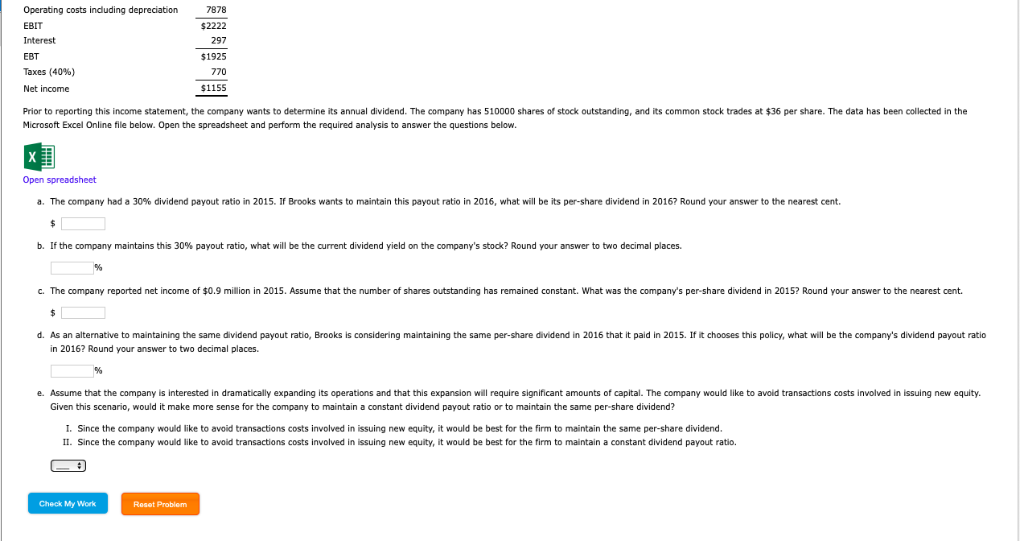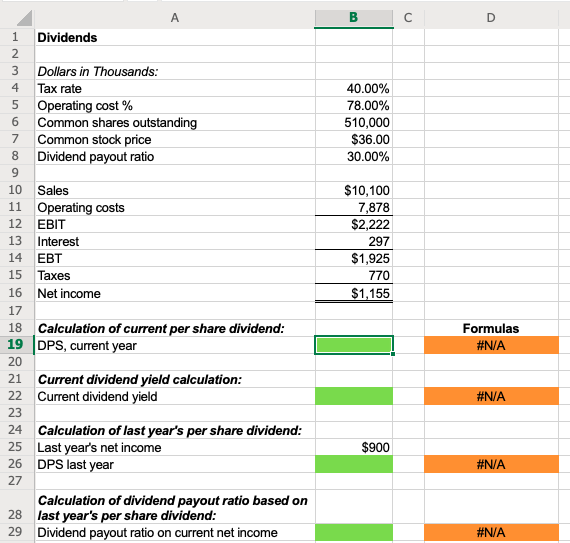Thank you for the help. Will rate if correct !! For the Year 2016!!


7878 $2222 297 $1925 770 $1155 Operating EBIT Interest EBT Taxes (40%) Net income costs induding depreciation Prior to reporting this income statement, the company wants to determine its annual dividend. The company has 510000 shares of stock outstanding, and its common stock trades at $36 per share. The data has been collected in the Microsoft Excel Online file below. Open the spreadsheet and perform the required analysis to answer the questions below. Open spreadsheet a. The company had a 30% dividend payout ratio in 2015. If Brooks wants to maintain this payout ratio in 2016, what will be its per-share dividend in 2016? Round your answer to the nearest cent b. If the company maintains this 30% payout ratio, what will be the current dividend yield on the company's stock? Round your answer to two decimal places. c. The company reported net income of $0.9 million in 2015. Assume that the number of shares outstanding has remained constant. What was the company's per-share dividend in 2015? Round your answer to the nearest cent. d. As an alternative to maintaining the same dividend payout ratio, Brooks is considering maintaining the same per-share dividend in 2016 that it paid in 2015. If it chooses this policy, what will be the company's dividend payout ratio in 2016? Round your answer to two decimal places. e. Assume that the company is interested in dramatically expanding its operations and that this expansion will require significant amounts of capital. The company would like to avoid transactions costs involved in issuing new equity. Given this scenario, would it make more sense for the company to maintain a constant dividend payout ratio or to maintain the same per-share dividend? . Since the company would like to avoid transactions costs involved in issuing new equity, it would be best for the firm to maintain the same per-share dividend . Since the company would like to avoid transactions costs involved in issuing new equity, it would be best for the firm to maintain a constant dividend payout ratio Check My Work Reset Probiem 1 Dividends 3 4 5 6 7 8 Dollars in Thousands: Tax rate Operating cost % Common shares outstanding Common stock price Dividend payout ratio 40.00% 7800% 510,000 $36.00 30.00% 10 Sales 11 Operating costs 12 EBIT 13 Interest 14 EBT 15 Taxes 16 Net income 17 18 Calculation of current per share dividend 19 DPS, current year 20 $10,100 7,878 $2,222 297 $1,925 770 $1,155 Formulas #N/A 21 22 23 24 25 26 27 Current dividend yield calculation Current dividend yield Calculation of last year's per share dividend Last s net income DPS last year $900 Calculation of dividend payout ra last year's per share dividend: Dividend payout ratio on current net income tio based on 28 29 #N/A 7878 $2222 297 $1925 770 $1155 Operating EBIT Interest EBT Taxes (40%) Net income costs induding depreciation Prior to reporting this income statement, the company wants to determine its annual dividend. The company has 510000 shares of stock outstanding, and its common stock trades at $36 per share. The data has been collected in the Microsoft Excel Online file below. Open the spreadsheet and perform the required analysis to answer the questions below. Open spreadsheet a. The company had a 30% dividend payout ratio in 2015. If Brooks wants to maintain this payout ratio in 2016, what will be its per-share dividend in 2016? Round your answer to the nearest cent b. If the company maintains this 30% payout ratio, what will be the current dividend yield on the company's stock? Round your answer to two decimal places. c. The company reported net income of $0.9 million in 2015. Assume that the number of shares outstanding has remained constant. What was the company's per-share dividend in 2015? Round your answer to the nearest cent. d. As an alternative to maintaining the same dividend payout ratio, Brooks is considering maintaining the same per-share dividend in 2016 that it paid in 2015. If it chooses this policy, what will be the company's dividend payout ratio in 2016? Round your answer to two decimal places. e. Assume that the company is interested in dramatically expanding its operations and that this expansion will require significant amounts of capital. The company would like to avoid transactions costs involved in issuing new equity. Given this scenario, would it make more sense for the company to maintain a constant dividend payout ratio or to maintain the same per-share dividend? . Since the company would like to avoid transactions costs involved in issuing new equity, it would be best for the firm to maintain the same per-share dividend . Since the company would like to avoid transactions costs involved in issuing new equity, it would be best for the firm to maintain a constant dividend payout ratio Check My Work Reset Probiem 1 Dividends 3 4 5 6 7 8 Dollars in Thousands: Tax rate Operating cost % Common shares outstanding Common stock price Dividend payout ratio 40.00% 7800% 510,000 $36.00 30.00% 10 Sales 11 Operating costs 12 EBIT 13 Interest 14 EBT 15 Taxes 16 Net income 17 18 Calculation of current per share dividend 19 DPS, current year 20 $10,100 7,878 $2,222 297 $1,925 770 $1,155 Formulas #N/A 21 22 23 24 25 26 27 Current dividend yield calculation Current dividend yield Calculation of last year's per share dividend Last s net income DPS last year $900 Calculation of dividend payout ra last year's per share dividend: Dividend payout ratio on current net income tio based on 28 29 #N/A








